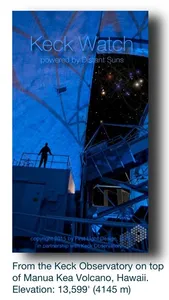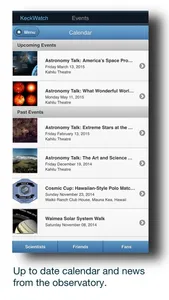KeckWatch is brought to you by W. M. Keck Observatory, which operates the two largest optical/infrared telescopes on Earth from nearly 14,000 feet on Maunakea in Hawaii. Since first science in 1993 they have become the two most scientifically productive telescopes on Earth.
With KeckWatch, you can share in their discoveries. Sporting thousands of stars, all 8 (sorry, Pluto) planets, galaxies, nebula and star clusters, along with status updates and news from Keck Observatory you’ll learn where Orion might be, or what planet was shimmering above the house last night.
Features include:
•No Internet required. Just a sense of wonder.
•Up to date Keck news
•See the current status of each telescope, what instruments are in use and what organization is booked for that evening’s observing
•See where each scope is currently aimed.
•Stars are shown with both standard and traditional Hawaiian names
•Zoom in on the planets, see Jupiter and her moons or the rings of Saturn.
•See where other users with Beacons.
•Compass aware, just aim and gaze.
•Thousands of pinpoint stars scintillating like diamond dust in the palm of your hand
•Realistic ghostly band of the Milky Way
•Stories behind each constellation
•Viewpoint Lock keeps any planet centered
•Galaxies, nebula and star clusters
•Hubble Space Telescope images
•All 8 planets (Pluto is optional)
•GPS aware
•Red interface to preserve your night vision
•What's Up? Gives a quick one snapshot overview of where all of the important stuff is
•Touching the sky to reveal hidden data for each object
•Planetary data and information
With KeckWatch, you can share in their discoveries. Sporting thousands of stars, all 8 (sorry, Pluto) planets, galaxies, nebula and star clusters, along with status updates and news from Keck Observatory you’ll learn where Orion might be, or what planet was shimmering above the house last night.
Features include:
•No Internet required. Just a sense of wonder.
•Up to date Keck news
•See the current status of each telescope, what instruments are in use and what organization is booked for that evening’s observing
•See where each scope is currently aimed.
•Stars are shown with both standard and traditional Hawaiian names
•Zoom in on the planets, see Jupiter and her moons or the rings of Saturn.
•See where other users with Beacons.
•Compass aware, just aim and gaze.
•Thousands of pinpoint stars scintillating like diamond dust in the palm of your hand
•Realistic ghostly band of the Milky Way
•Stories behind each constellation
•Viewpoint Lock keeps any planet centered
•Galaxies, nebula and star clusters
•Hubble Space Telescope images
•All 8 planets (Pluto is optional)
•GPS aware
•Red interface to preserve your night vision
•What's Up? Gives a quick one snapshot overview of where all of the important stuff is
•Touching the sky to reveal hidden data for each object
•Planetary data and information
Show More




